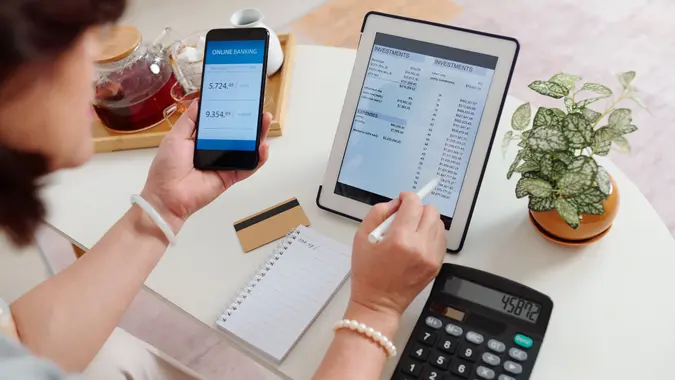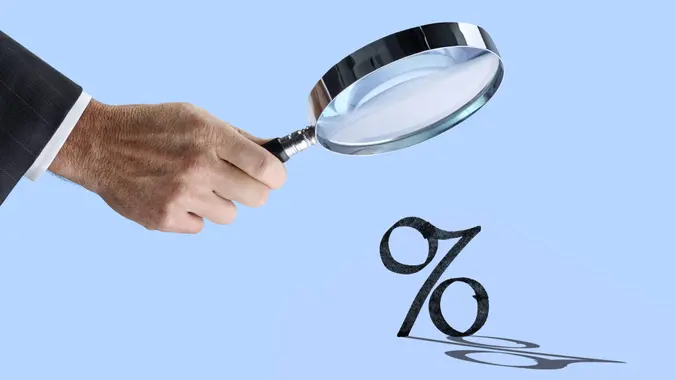Rachel Cruze: How To Use Your Bank To Put Your Paycheck Routine on Autopilot

Commitment to Our Readers
GOBankingRates' editorial team is committed to bringing you unbiased reviews and information. We use data-driven methodologies to evaluate financial products and services - our reviews and ratings are not influenced by advertisers. You can read more about our editorial guidelines and our products and services review methodology.

20 Years
Helping You Live Richer

Reviewed
by Experts

Trusted by
Millions of Readers
Ah, payday. It’s the best day of the week — or every other week, or the month. Like clockwork, you can count on that direct deposit hitting your bank account, giving you the funds to move forward with your financial goals: paying your bills, contributing to your retirement accounts, investing — you name it.
Unless, of course, you forget to move the money over. It happens. You get busy. Life gets hectic, and as chores and daily responsibilities pile up, transferring funds manually falls to the bottom of your to-do list. This common experience is why financial experts like Rachel Cruze advocate for creating a paycheck routine to help you maximize every dollar.
Your bank can be a key ally in this process. With easy-to-set-up tools and resources available at almost any bank, you can set up an automated paycheck routine that serves your financial goals — and requires minimal effort.
Automate What You Can
You don’t have to worry about forgetting to pay your bills if the funds are automatically zipping out of your account each month. “Technology sets us up for convenience when it comes to our money,” said Cruze. “So being confident that things are getting paid by putting them on autodraft is a very wise choice.”
By setting up autopay, you can schedule bill payments to align with your pay periods. Rather than experience the anxiety of having all your bill payments withdrawn at once, you can stagger them while still meeting your due dates.
Create a Routine To Pay Down Debt
Of course, everyone’s paycheck routine will look different, guided by individual financial goals. If you’re one of the many people dealing with debt, you’ll want to tailor your routine to pay it down as quickly as possible.
Cruze recommends starting with a budget app — or even a low-tech pen-and-paper method if you prefer — to track the exact amount of every paycheck. Your monthly budget should include your total household income, including money from a partner’s paycheck or side gigs.
Some banks even offer built-in budgeting tools that sync with your account. Every bank is different, though, so you’ll want to take the time to explore what’s available at your bank.
From there, list your essential expenses, or what Cruze calls “the four walls”: housing, food, transportation, and utilities. Next, outline all your debts, starting with the smallest balance owed and working up to the largest. Include the minimum payments for each.
Once everything is clearly laid out, allocate what’s left in your budget to other expenses, prioritizing them from most to least urgent. After finalizing your budget, create a schedule to automate your debt payments. By doing this, you’ll not only ensure you stay on track but also remove the temptation to spend money elsewhere.
Automate Savings When You’re Debt-Free
Ideally, you’ll reach a point where you’re debt-free, allowing you to shake up your paycheck routine. You’ll be free to use the money you would have spent paying down your debt to build an emergency fund, save for a down payment on a home, or other financial goals. And one of the best ways to ensure you meet those goals is to automate your savings.
For your emergency fund, consider a high-yield savings account (HYSA), which allows your money to earn interest over time. Since it’s relatively easy to withdraw your money from a HYSA, it’s a particularly smart option for an emergency fund.
To take this one step further, set up automatic transfers from your checking account into your HYSA that align with your paycheck’s direct deposit. For example, you could move 10% of your paycheck into savings automatically. If your timeline for accessing funds is longer, you might also look into certificates of deposit (CDs) available at your bank, as they often offer higher interest rates for fixed time periods ranging from a few months to several years.
To ensure you’re choosing the right accounts for you, check whether your bank offers financial planning assistance. Cruze reminds us that every bank account is different, so before you set anything up, make sure there aren’t mandatory minimum deposits or fees before opening a new account.
Remember, Not All Banks Are Created Equal
At the end of the day, no matter how helpful your bank’s tools and resources may be, when it comes to your financial success, the buck quite literally stops with you. “Don’t forget, personal finance is all about behavior,” said Cruze. “So creating good habits with your money — not just relying on technology, is still important to remember.”
Automating where possible is a smart move to save time, eliminate human error, and keep your goals on track. But ultimately, success comes from pairing automation with disciplined financial habits that you maintain over time.
 Written by
Written by  Edited by
Edited by 
























